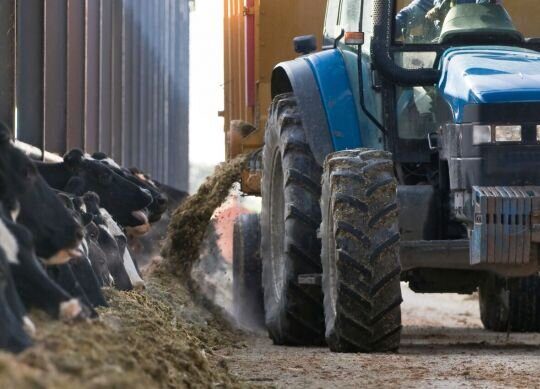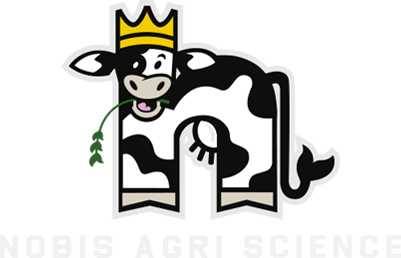Feed mixing and delivery: The importance of maximizing accuracy
Feed mixing and delivery is one of the most important activities on the dairy. Mixing and feeding a total mixed ration (TMR) is a multiple-times-per-day activity. Doing this job accurately and consistently time and time again, batch after batch and day after day is critical to production, animal health and overall farm economics.
Accuracy and consistency of mixing and feed delivery may be one of the greatest effectors of production and feed efficiency on the farm. Economically speaking, we might go by a simple rule of thumb: 1 pound of dry matter intake (DMI) equals 1.5 to 2 pounds of milk production.
Using a basic milk value of $18 per hundredweight, a variation of just 1 pound of DMI can mean a change in milk revenue of 27 cents to 36 cents per head per day. On a 300-day lactation basis, this could equal $81 to $108 per head. To expand more, if your ration costs equal $6 per head per day and your target is 52 pounds of DMI, 1 pound of dry matter (DM) is equal to 11 cents. So while feeding a pound less of DM might save 11 cents, the production loss can average 20.5 cents per head per day or $61.50 per head over a 300-day lactation. This is equal to a $61,500 loss annually for a 1,000-cow dairy. Again, this is because of underfeeding 1 pound of DM per day. That does not include the effect the variation in other nutrients might have.
There are at least four versions of every ration fed on the dairy: The one formulated, the one mixed, the one delivered and the one the cows actually eat. Going from formulated to consumed can be a significant challenge. If we assume the formulation is as accurate as it can be for a particular group of cows, obviously the goal is mixing a feed as close to the formulation as possible. This is not an easy job.
It starts with ingredients
A major part of feeding accuracy is based on the ingredients going into the rations. In general, the degree of variability can be ranked. The list below is in order from most to least variable:
1. Silages: Most silage is commonly the most variable ingredient on a day-to-day and often batch-to-batch basis. The primary variation is moisture level. Moisture can vary large amounts and needs to be adjusted in the formula or in the feed management system if the farm uses one. Regular monitoring of DM is important to maintain consistent DMI. This affects levels of all other nutrients and can directly affect digestibility.
2. Hays: Dry hay is variable but not as variable as silage. Variation for hays, particularly alfalfa, can vary quite a lot in terms of protein, fiber components and relative feed value (RFV). This is particularly true for purchased hay, especially if the source is not well-known. Buying hay through brokers can result in supplies from multiple producers. Even if the seller provides a test of the hay, there is no guarantee of what the nutrient values of the actual hay purchased truly are.
3. Byproduct commodities: Commodities such as dry distillers grain (DDG), corn gluten feed, hominy, etc., are notoriously variable. Remember, these are byproducts. Consistency and quality are generally not of great concern of the suppliers. As with hay, it is important to recognize that purchasing byproduct ingredients will be more variable than from a consistent known source. Ingredients such as wet distillers or brewers grains fall into the same category for variability.
4. Cereal grains, proteins: Corn, soybean meal, etc., are fairly consistent and are the least variable of the major ingredients. Some variation can be injected with processing. This most commonly comes with heat/moisture processing, i.e., steam flaked or steam rolling can increase variation with the moisture applications. Products like high-moisture corn are similarly variable.
5. Minerals, vitamins, additives: Most of the variation with these ingredients is based more on the mixing than to the actual manufacture of the individual components. Most of these ingredients are manufactured under strict quality assurance guidelines. Since most of the time these come to the farm in a premix, the variation may be related more to the equipment and abilities of the source mill.
When you consider the natural variations in moisture and nutrients, it becomes obvious that delivering a consistent, accurate feed batch after batch can be very difficult. Every farm needs its own quality control program that starts with the ingredients used and with the nutritionist having the most accurate values available. Diet formulations are only as good as the accuracy of the nutrient data for forages and feeds. This means that regular testing and analyses is an important part of the program. Development of a sound testing and analysis program and working with a lab that can provide a quick, accurate turnaround is essential.
Sampling and analyses of ingredients
Sampling and nutrient analysis has been a common practice on the dairy for years. Moisture testing for higher-moisture ingredients day to day or even batch to batch is a critical part of the feed mixing process. Since diet formulations are dependent on DM and the subsequent nutrient delivery, knowledge of DM contents in real time are important. Sampling and DM analyses and adjustment of ingredient DM values should be a core part of mixing and delivery of each batch. The most common on-farm moisture analyses methods are still oven drying methods. Oven drying is simple, reasonably fast and fairly accurate. More advanced methods include the use of portable on-farm near-infrared (NIR) units which are very fast and accurate. The downside is: There is more cost to these units. However, the improved ration accuracy and improved milk production that can come generally make an NIR unit cost-effective.
Sampling of ingredients for other nutrients is similarly important. Unfortunately, this is often “after the fact” given how rapidly a farm might go through inventory. Ingredients should be sampled and analyzed regularly to ensure the base values (protein, fiber components, etc.) are within acceptable parameters so ration consistency is maintained.
Finally, the rations themselves should be tested periodically with sampling at the mixer and in the bunk sampled, tested and compared. This needs to include a particle size analyses. It is also of value to sample and test the ration at the bunk, after the cows have had a chance to consume at least half of the feed delivered. This can provide some indicator (as well as other methods) of the amount of sorting that may be taking place to provide an idea of what the cow is actually receiving.
Farm employees should be trained in proper sampling techniques as well as packaging, storage and handling of samples.
Accuracy of feed delivered to bunk
In addition to a knowledge of DM levels and that of other nutrients, a number of other factors will affect the accuracy of the diet from formulation to delivery.
1 Feeder ability and training: Whoever is mixing and delivering the feed must understand the process and importance. On some farms, it may be the owner who handles this process so there is a vested interest. The owner needs to be completely familiar with the whole process because it so directly affects the bottom line. If mixing and feed delivery is handled by employees, the critical nature of the process must be impressed on them, and they need to be well trained. If there are multiple employees involved in the process, each of them should be completely familiar with the process. Training should be ongoing.
2 Equipment: There are multiple types and brands of mixers, each with their own positives and negatives. First, owners and feeders should, again, be completely familiar with the equipment. On some farms, this may include only a tractor/mixer and a tractor/loader. In others, this may be more complex and extensive. Each piece of equipment should be well maintained and constantly examined for proper function. Knives and stops in vertical mixers should be kept sharp, since hay “chopping” is important to the process.
3 Scales: Scales should be regularly checked for accuracy and functionality. If they are tied in electronically to a feeding or feed monitoring system, the interface should likewise be checked periodically to ensure accuracy of reporting.
4 Feed delivery: When delivering the ration to the bunk for a pen/group of cows, it is very important the delivery is made smoothly with even amounts of feed delivered from one end of the bunk to another. Remember, cows like consistency and are also creatures of habit. In many cases, a given cow will return to approximately her same feeding location (within a few feet) every day. So even, accurate feed delivery is a must.
Conclusions
Accurate feed mixing and delivery is a difficult task but should be the goal of every farm. Work with your nutritionist and employees to develop a comprehensive, accurate formulation to consumption program. The more consistently feed is mixed and delivered as related to formulations, the better production, components and economics should be.
Adapted from Dr. Steve Blezinger for Progressive Dairy



